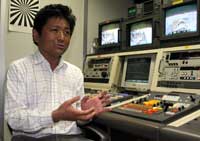
Mr. Maeda discussing his film.

縲In his film 窶弋he Day the Sun Disappeared,窶・Minoru Maeda, 36, focuses on life before the bombing. 窶弩hen I thought about children at play before the bomb was dropped, I realized they were just like us,窶・he said. 窶廝ut then they lost that way of life.窶・/p>
縲The film begins with a scene in which boys wearing 窶徃eta窶・(traditional Japanese sandals) are playing in the street. Approximately 80% of the 19-minute film is composed of views of the city before the bombing. The creative process involved gathering a variety of materials, including photos, maps, and the stories of A-bomb survivors. The film took 10 years to complete and it was first screened in 2002.
縲窶廬窶冦 pleased if my film inspires people to visit places like Peace Memorial Museum to learn more about the bombing,窶・he added.
縲Akito Kawamoto has made films of his family and other atomic bomb survivors since he first bought an 8mm camera 50 years ago. His wife, Kiyoko, 81, is also an A-bomb survivor and she has appeared in several of his films.
縲In 1968, Kiyoko developed thyroid cancer. Despite his worry, he shot footage of her fighting the cancer and raising their children. 窶廡or the first time, I felt the burden of Hiroshima窶冱 legacy,窶・he said. 窶弩hen my wife suffered, I suffered.窶・And so he has tried to express his anger and sorrow towards war through his film work.
縲窶廬 want young people to see my films,窶・Mr. Kawamoto said. 窶廬窶冦 happy to show my films at schools.窶・In all, he has made 12 movies related to the atomic bomb and these films have received awards both in Japan and abroad.
縲His next film, about a survivor who draws pictures of the bombing, will be finished this fall. (Naru Nishida, 16)
縲The Hiroshima chapter of the Japan Realism Photo Group studies Hiroshima from various points of view. The leader of the group, Kunihisa Seki, 64, has focused on a willow tree standing by Tsurumi Bridge that managed to survive the bombing.
縲THis photos trace the history of the tree, from a fragile figure supported by a pole in 1987 to its healthy revival through care and transplanting. 窶廬n order to pass on the reality of the atomic bomb, we need to preserve the details of the experience.窶・/p>
縲Some images by Takahiro Tamori, 57, show the ruins of the platform in an old train station and the wreck of the former military pier. During the war, many soldiers went into battle from this spot. Mr. Tamori thinks, 窶弋o grasp the complete picture of Hiroshima, we also need to see our role as aggressor, too.窶・/p>
縲Students in this course at Motomachi High School made short films with the theme 窶弩ishes for Peace, from Hiroshima窶・/p>
縲First, they conducted observations in the city and collected impressions. Then, based on these impressions, they created six films using animation, hand-drawn illustrations, and photos.
縲Students at Kokutaiji High School made a video called 窶廸i Hao to You窶・which deals with the complicated relationship between Japan and China from the perspective of high school students. It stresses the 窶從eed to learn from the past in order to build a positive relationship with a Chinese classmate窶・
縲Yuki Nakabayashi, 17, acted in the video. She recalls that, 窶廣s a student in Hiroshima, this project made me think about the importance of learning from history and promoting peace.窶・/p>
縲The club has 17 members. They produce 6 or 7 videos and radio dramas a year.
縲Since 2000, members of the Photography Club have taken pictures on August 6th at the Peace Memorial Ceremony in Hiroshima. They try to record the many moments of that day, with images that include the A-bomb Dome, floating lanterns, and children.
縲Shigemi Tamura, the club窶冱 teacher-advisor, says, 窶弩e sometimes take photos early in the morning or at night. But taking good photos is not our only aim; we also try to nurture an interest in peace and social issues.窶・/p>